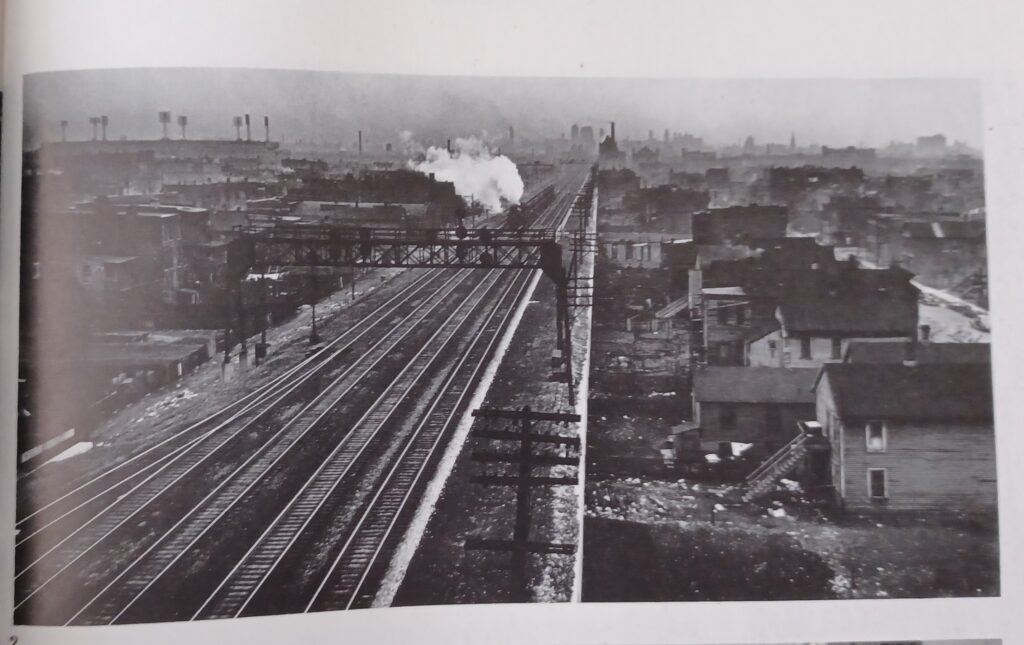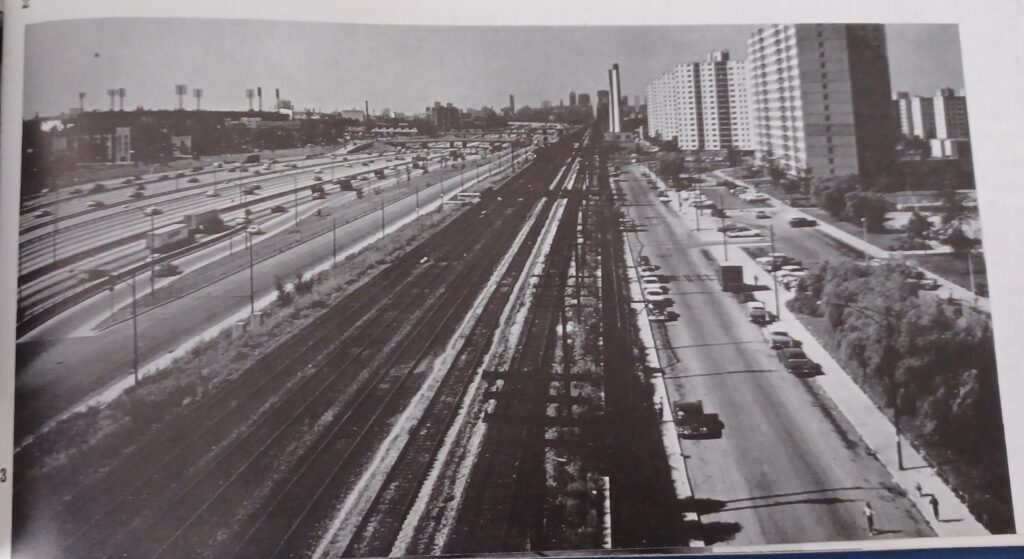Urban Renewal? Or Urban Injustice?
By Ayah Kudaimi
These two pictures are before and after views of the Dan Ryan Expressway on the South Side. The first picture was taken in 1943 and the second was taken in 1963. In the first photo, the railroad tracks are already cutting through the South Side neighborhood. We see run down homes, polluted air and streets and factories’ smokestacks in the background. All of these are signs of an impoverished neighborhood, none of course of the communities’ fault. The second photo is taken of the South Side, but further away. There are more railroad tracks than in the first photo. The beaten down homes on both sides of the tracks have been cleared away and the families that occupied those homes were also forcibly removed. To the East of the tracks, high rise public housing has been erected. To the West is the Dan Ryan Expressway. The second photo shows the South Side looking very neat, clean, and organized.
In those 20 years, the city of Chicago built the I-94 that straight went through the South Side community. The purpose of building highways was to connect the suburbs to the city and keep whites coming for the economic prosperity of the city.3
This was one of the big building projects championed by Mayor Richard J Daley. These projects made the city look good and made Mayor Daley fulfill promises to certain constituents.1 Thousands of federal dollars went to projects like these that would improve the city. It is a process known as Urban Renewal. The purpose was to revitalize the city, with big building projects that would bring in white people and businesses. But whole communities were uprooted to build that highway and many others. Building expressways was the single greatest cause of community upheaval between 1948 and 1966. 4 Is Urban Renewal for everyone? Is it equal in serving all communities regardless of color? The short answer is no. The proper term for this should be urban injustice. The real purpose was to fight back against white flight to the suburbs. All that money that went to building those the failed public housing projects and freeways, should have gone to repairing those homes in the first photo. It shows a lack of renovation for better, more decent living communities for all people regardless of skin color. Those homes were left in disrepair because landlords were not willing to upgrade them, instead they charged residents higher rent each year.
Chicago used Urban Renewal as an excuse to clear what they called “slums” or blighted areas such as those on the South Side in the first photo that had run down homes. Slum Clearance was one policy that the city of Chicago pursued to build those huge projects. It was a pattern of decisions by the city targeting communities of color, such as those on the South Side and Near West Side. The city let these neighborhoods turn into disarray and slums. Mayor Daley avoided talking about race and wouldn’t answer questions about whether his policies discriminated against Black, Brown, and other communities.3 He touted slum clearance/urban renewal as a necessary effort that city must undertake. He had plans to make the city look great but did so at the cost of these working class communities. He needed these communities of color to vote for him each election cycle, despite the harm that his decisions inflected.
He had the electorate under his control. He did not allow for dissent.5 When these communities made demands for change, such as the Near West Side Planning Board, Daley ignored them. The Near West Side Planning Board was an organization that operated in the Near West Side and they demanded the city build new housing to replace many of the run down homes in the area. The city promised that it would build public housing.1 At the same time, the University of Illinois was considering a new location to move its Navy Pier Campus. There were up to 60+ locations considered. Mayor Daley saw the importance of the new campus to be in Chicago. Many white students in the nearby suburbs and in the city were going to need a college education.* So the Mayor advocated for the Harrison-Halsted area in the Near West Side to be the location of the new U of I campus.
To do this though, the many communities of the Near West Side who had been promised public housing would have to have their neighborhoods cleared, to build it. They felt betrayed by Daley, but he had vested interests behind him. Business leaders wanted to close off the Loop, keep businesses in, keep Blacks out and the way to do that was to build highways and a university. In 1961, the city and U of I agreed that the location of the new campus should be in the Near West Side specifically the Harrison-Halsted area. Black, Greek, Latino, and Italian communities that called the Near West Side home, were booted out. All of this was done in the name of rejuvenating the city, but what about the injustice of uprooting so many people in the South Side, Near West Side and many other neighborhoods. Is this Urban Renewal for all or Urban Injustice for many?
- Mayer, Harold M, Glen E Holt, and Richard C Wade. Chicago : Growth of a Metropolis ; Cartography by Gerald F. Pyle. Chicago: Univ. of Chicago Press, 2002 ↩︎
- Mayer, Harold M, Glen E Holt, and Richard C Wade. Chicago : Growth of a Metropolis ; Cartography by Gerald F. Pyle. Chicago: Univ. of Chicago Press, 2002 ↩︎
- Fernandez, Lilia. Brown in the Windy City : Mexicans and Puerto Ricans in Postwar Chicago. Chicago: The University of Chicago Press, 2012. ↩︎
- Mayer, Harold M, Glen E Holt, and Richard C Wade. Chicago : Growth of a Metropolis ; Cartography by Gerald F. Pyle. Chicago: Univ. of Chicago Press, 2002. ↩︎
- Royko, Mike. Boss : Richard J. Daley of Chicago. New York Plume, 1988. ↩︎

